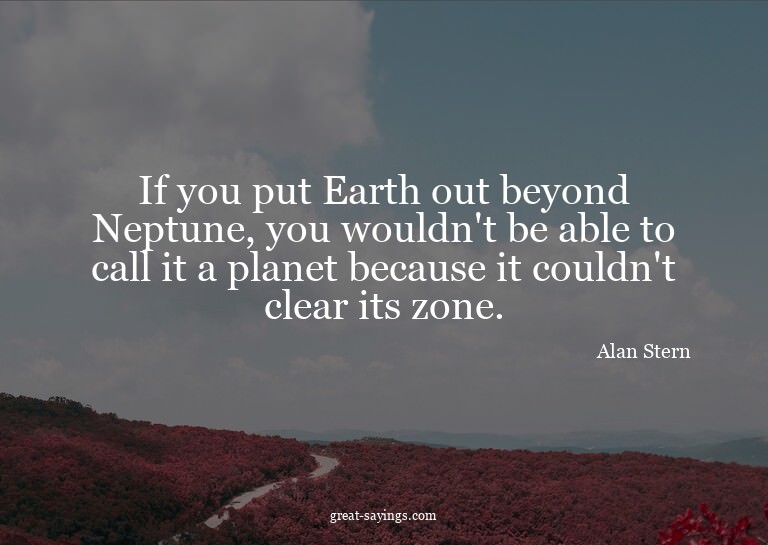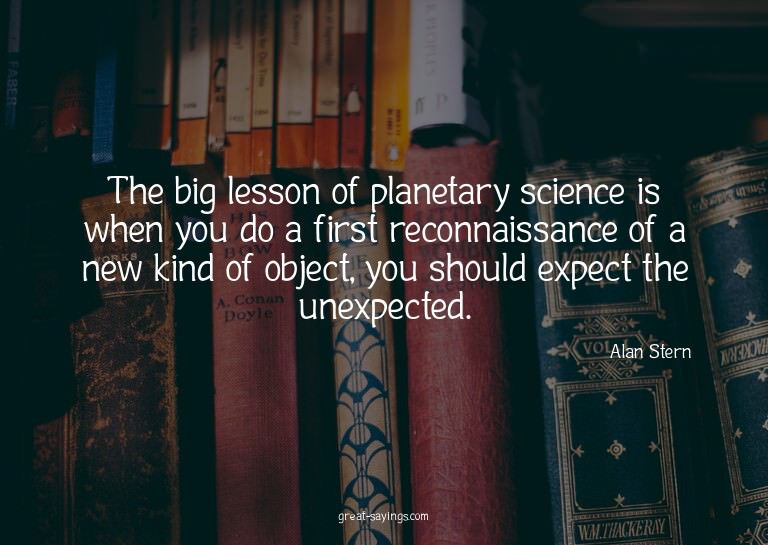Words matter. These are the best Alan Stern Quotes, and they’re great for sharing with your friends.

If you put Earth out beyond Neptune, you wouldn’t be able to call it a planet because it couldn’t clear its zone.
Human beings have long wondered whether they are alone in the universe.
If two billion people wanted to watch a robot fly by Pluto, imagine what it will be like when the first humans step on Mars. It’ll be the most unifying event anybody could ever put on.
During one of the Apollo missions, I saw Walter Cronkite showing off the flight plan. It just mesmerized me. All this detail! That’s what I wanted.
Of course Pluto is a planet: It’s massive enough to have its shape controlled by gravity rather than material strength, which is the hallmark of planethood.
When we first sent missions to Jupiter, no one expected to find moons that would have active volcanoes. And I could go down a long list of how often I’ve been surprised by the richness of nature.
How can an adjective in front of a noun not describe the noun? There are dwarf stars, but they’re still considered stars.
We made more than just scientific discoveries… we rediscovered how much people love exploration.
A miniature poodle is not not a dog just because it’s miniature.
I tell public audiences, don’t go to a podiatrist for brain surgery; don’t go to an astronomer for planetary science.
Back before the Kuiper Belt was discovered, Pluto did look like a misfit that didn’t belong with either the terrestrials or the giant planets.
In science, we take large numbers of disparate facts and reduce them to see patterns. We use the patterns to reduce the amount of information. It’s the reason we name species and genera and families in biology. It’s also the reason we have names for certain types of geological features and so on in other fields.
I think if you were between maybe 6 and 16, there was nothing like Apollo, and I wonder if there can be something like that again. We’ll just have to see.
If the Pluto mission was a cat, then it would’ve been dead long ago because they only get nine lives, and we’ve had significantly more than nine stoppages and odd twists and turns.
Pluto and its brethren are the most populous class of planets in our solar system.
I like the planets because they are real places that you can go to and send machines to. Faraway astronomy – galactic astronomy and extra-galactic astronomy – is really cool stuff, but to me, it’s about destinations.
No one predicted Mercury would be a planetary core with the mantle stripped off. No one predicted volcanoes on the Jovian moons, or oceans on the inside of them. I can tell you, for every single planet, huge ‘we never guessed that’ things.
One thing scientists do is to find order among a large number of facts, and one way to do that across fields as diverse as biology, geology, physics and astronomy is through classification.
Competition-driven innovation and price pressure that commercial practices foster can only make human spaceflight ever more common and U.S. leadership in this domain ever clearer.
As a researcher, I look forward to being able to do space science in a space environment.
The basic story for Golden Spike is that we discovered a way to create do-it-yourself Apollo programs for other countries.
CSF and its members believe strongly in the exploration of space of all kinds, including commercial purposes.
Science is really about individual experts reaching a consensus.
I call Pluto the harbinger.
By going to Pluto, we have a chance to anchor, with real data, models of the early evolution of Earth’s atmosphere.
It’s interesting – Pluto’s almost a brand unto itself. It’s the farthest. It’s the most diminutive of the classical planets. It’s been maligned by astronomers. It’s always the one with all the question marks in the back of the textbook in the table. I think children identify with it because it’s smaller, kind of cute.
The Kuiper Belt is the largest mapped structure in our planetary system, three times as big as all the territory from the sun out to Neptune’s orbit.
The first mission to Mars did not expect to find craters and river valleys, and yet they did. The first mission to Jupiter didn’t expect to find ocean worlds and volcano worlds, but they did.
New Horizons is a very high-tech, small, roughly 1,000-pound spacecraft with the most powerful battery of scientific instrumentation ever brought to bear on a first reconnaissance mission.
Pluto has strong atmospheric cycles: it snows on the surface; the snows sublimate and go back into the atmosphere each 248 year orbit.
Pluto is as far across as Manhattan to Miami, but its atmosphere is bigger than the Earth’s.

The big lesson of planetary science is when you do a first reconnaissance of a new kind of object, you should expect the unexpected.
The Pluto system is much more complex than I had expected.
Science doesn’t work by voting. Did people vote on the theory of relativity? No! It’s either right or it’s wrong. Do we vote on whether genetics is a good theory or not? Of course not.
Pluto has a very interesting history, and there is a lot of work that we need to do to understand this very complicated place.
It says something very deep about humans and our society, something very good about us, that we’ve invested our time and treasure in building a machine that can fly across three billion miles of space to explore the Pluto system.
New Horizons isn’t just visiting Pluto; it’s visiting this entire region. Whatever it finds, this will be a signal moment for planetary exploration – the capstone to our first reconnaissance of the planets of our solar system.
My field is called planetary science.
It is only by freeing NASA from routine human transport to low-Earth orbit that we can afford to once again see American astronauts exploring distant worlds.
There was a time when Pluto – which NASA’s New Horizons spacecraft at last explored in 2015, a mission I led – was considered the last planet. We now know there are thousands of other – possibly inhabited – planets.
Are governments the only entities that can build human spacecraft? No – actually, every human spacecraft ever built for NASA was built by private industry.
Having a diverse suite of U.S.-manned spaceflight systems to access space is inherently robust.
As a planetary scientist, I don’t know what else to call Pluto: It’s big and round and thousands of miles wide.
When I started working with NASA in 1989 as part of a mission to send spacecraft to Pluto, I knew it would take at least 10-15 years to see results of my efforts.
One of the implications of the discovery of the Kuiper Belt and its many small planets is that many scientists now think of the solar system as having not two but three zones.












